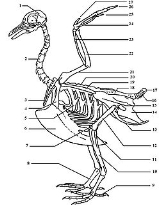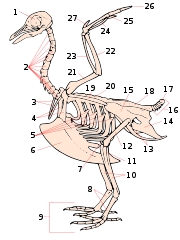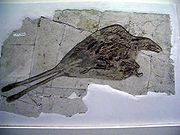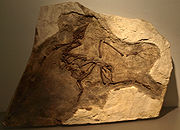
Pygostyle
Encyclopedia


Ossification
Ossification is the process of laying down new bone material by cells called osteoblasts. It is synonymous with bone tissue formation...
, supporting the tail feather
Feather
Feathers are one of the epidermal growths that form the distinctive outer covering, or plumage, on birds and some non-avian theropod dinosaurs. They are considered the most complex integumentary structures found in vertebrates, and indeed a premier example of a complex evolutionary novelty. They...
s and musculature. In modern bird
Bird
Birds are feathered, winged, bipedal, endothermic , egg-laying, vertebrate animals. Around 10,000 living species and 188 families makes them the most speciose class of tetrapod vertebrates. They inhabit ecosystems across the globe, from the Arctic to the Antarctic. Extant birds range in size from...
s, the rectrices attach to these.
The pygostyle is the main component of the structure colloquially known as Pope
Pope
The Pope is the Bishop of Rome, a position that makes him the leader of the worldwide Catholic Church . In the Catholic Church, the Pope is regarded as the successor of Saint Peter, the Apostle...
's nose, parson's nose or sultan's nose. This is the fleshy protuberance visible at the posterior end of a bird
Bird
Birds are feathered, winged, bipedal, endothermic , egg-laying, vertebrate animals. Around 10,000 living species and 188 families makes them the most speciose class of tetrapod vertebrates. They inhabit ecosystems across the globe, from the Arctic to the Antarctic. Extant birds range in size from...
(most commonly a chicken
Chicken
The chicken is a domesticated fowl, a subspecies of the Red Junglefowl. As one of the most common and widespread domestic animals, and with a population of more than 24 billion in 2003, there are more chickens in the world than any other species of bird...
or turkey
Turkey (bird)
A turkey is a large bird in the genus Meleagris. One species, Meleagris gallopavo, commonly known as the Wild Turkey, is native to the forests of North America. The domestic turkey is a descendant of this species...
) that has been dressed for cooking
Cooking
Cooking is the process of preparing food by use of heat. Cooking techniques and ingredients vary widely across the world, reflecting unique environmental, economic, and cultural traditions. Cooks themselves also vary widely in skill and training...
. It has a swollen appearance because it also contains the uropygial gland
Uropygial gland
The uropygial gland, informally known as the preen gland, is a gland found in the large majority of birds that secretes an oil that birds use for preening. The chief compounds of preen oil are diester waxes called uropygiols....
that produces preen
Preen
- Birds :*Preen, personal grooming of a bird's feathers especially by using its beak*Preen gland, also called the uropygial gland, an oil gland found in many bird species*Preen oil, an oil made by the uropygial gland found in many bird species...
oil. Some people consider it to be a sweet and tender delicacy when cooked, whilst others might consider it rather greasy.
Evolution
Pygostyles probably started to evolveEvolution
Evolution is any change across successive generations in the heritable characteristics of biological populations. Evolutionary processes give rise to diversity at every level of biological organisation, including species, individual organisms and molecules such as DNA and proteins.Life on Earth...
very early in the Cretaceous
Cretaceous
The Cretaceous , derived from the Latin "creta" , usually abbreviated K for its German translation Kreide , is a geologic period and system from circa to million years ago. In the geologic timescale, the Cretaceous follows the Jurassic period and is followed by the Paleogene period of the...
, maybe 140-130 million years ago. The earliest known species
Species
In biology, a species is one of the basic units of biological classification and a taxonomic rank. A species is often defined as a group of organisms capable of interbreeding and producing fertile offspring. While in many cases this definition is adequate, more precise or differing measures are...
to have evolved a pygostyle were members of the Confuciusornithidae
Confuciusornithidae
Confuciusornithidae is a family of primitive birds from the early Cretaceous Period of China. It consists of four genera. About half of all the confuciusornithid specimens, including reprersentatives of all species, that have preserved feathers possess a pair of distinctive ribbon-like tail...
. The structure provided an evolutionary advantage, as a completely mobile tail like in Archaeopteryx
Archaeopteryx
Archaeopteryx , sometimes referred to by its German name Urvogel , is a genus of theropod dinosaur that is closely related to birds. The name derives from the Ancient Greek meaning "ancient", and , meaning "feather" or "wing"...
is detrimental to its use for flight control. Modern birds still develop longer caudal vertebrae in their embryo
Embryo
An embryo is a multicellular diploid eukaryote in its earliest stage of development, from the time of first cell division until birth, hatching, or germination...
nal state, which later fuse to form a pygostyle.
There are two main types of pygostyle: one, found in Confuciusornithidae, Enantiornithes
Enantiornithes
Enantiornithes is an extinct group of primitive birds. They were the most abundant and diverse avialans of the Mesozoic. Almost all retained teeth and clawed fingers on each wing, but otherwise looked much like modern birds externally. Over 50 species of Enantiornithines have been named, but some...
, and some other Mesozoic
Mesozoic
The Mesozoic era is an interval of geological time from about 250 million years ago to about 65 million years ago. It is often referred to as the age of reptiles because reptiles, namely dinosaurs, were the dominant terrestrial and marine vertebrates of the time...
birds, as well as in some oviraptorosaurs like Nomingia
Nomingia
Nomingia is a genus of oviraptorid theropod dinosaur hailing from the Late Cretaceous Bugin Tsav Beds of Mongolia.-Discovery and naming:...
, is long and rod- or dagger blade
Dagger
A dagger is a fighting knife with a sharp point designed or capable of being used as a thrusting or stabbing weapon. The design dates to human prehistory, and daggers have been used throughout human experience to the modern day in close combat confrontations...
-like. None of the known fossils with such pygostyles show traces of well-developed rectrices. The tail feathers in these animals consisted of downy fuzz and sometimes 2-4 central "streamers" such as those found in some specimens of Confuciusornis or in Paraprotopteryx
Paraprotopteryx
Paraprotopteryx is a genus of enantiornithine bird. Though initially reported to be from the Early Cretaceous Yixian Formation, later investigation showed the fossil actually came from the Qiaotou member of the Huajiying Formation of Fengning, Hebei Province, China, and is therefore of uncertain age...
.
By contrast, the function of the pygostyle in the terrestrial
Terrestrial animal
Terrestrial animals are animals that live predominantly or entirely on land , as compared with aquatic animals, which live predominantly or entirely in the water , or amphibians, which rely on a combination of aquatic and terrestrial habitats...
Nomingia is not known. It is notable however that its older relative Caudipteryx
Caudipteryx
Caudipteryx is a genus of peacock-sized theropod dinosaurs that lived in the Aptian age of the early Cretaceous Period . They were feathered and remarkably birdlike in their overall appearance....
had no pygostyle but a "fan" of symmetrical feathers which were probably used in social display. Perhaps such ornaments were widespread in Caenagnathoidea
Caenagnathoidea
Caenagnathoidea is a group of advanced oviraptorosaurian dinosaurs from the Cretaceous Period of what are now Asia and North America. They are distinct for their characteristically short, beaked, parrot - like skulls, often with bony crests atop the head...
and their relatives, and ultimately the oviraptorosaurian pygostyle evolved to help support them. The related Similicaudipteryx
Similicaudipteryx
Similicaudipteryx, meaning "similar to Caudipteryx" , is a genus of theropod dinosaur of the family Caudipteridae. Its fossil remains were recovered from the Jiufotang and Yixian Formations of northeastern China, dating to the early Cretaceous Period between 124 and 120 million years ago...
, described in 2008, also had a rod-like pygostyle, associated with a fan of tail feathers.

Plowshare
In agriculture, a plowshare is a component of a plow . It is the cutting or leading edge of a moldboard which closely follows the coulter when plowing....
-shaped. It is found in Ornithurae
Ornithurae
Ornithurae is the name of a natural group which includes all modern birds as well as their extinct relatives with plough-shaped pygostyles, a bone at the end of the tail which allows the tail feathers to fan and retract....
(living birds and their closest relatives), and in almost all flying species is associated with an array of well-developed rectrices used in maneuvring. The central pair of these attach directly to the pygostyle, just as in Confuciusornis
Confuciusornis
Confuciusornis is a genus of primitive crow-sized birds from the Early Cretaceous Yixian and Jiufotang Formations of China, dating from 125 to 120 million years ago...
. The other rectrices of Ornithurae are held in place and moved by structures called bulbi rectricium (rectricial bulbs), a complex feature of fat and muscles located on either side of the pygostyle. The oldest known species with such a pygostyle is Hongshanornis longicresta.
As evidenced by the oviraptorosauria
Oviraptorosauria
Oviraptorosaurs are a group of feathered maniraptoran dinosaurs from the Cretaceous Period of what are now Asia and North America. They are distinct for their characteristically short, beaked, parrot - like skulls, with or without bony crests atop the head...
n cases, the pygostyle evolve
Evolution
Evolution is any change across successive generations in the heritable characteristics of biological populations. Evolutionary processes give rise to diversity at every level of biological organisation, including species, individual organisms and molecules such as DNA and proteins.Life on Earth...
d at least twice, and rod-shaped pygostyles seem to have evolved several times, in association with shortening of the tail but not necessarily with a retractable fan of tail feathers. In other words, the pygostyles of oviraptorosaurs and Confuciusornis were likely weight-saving measures, and the specialized "true" pygostyles of ornithurans were adapted from these later to improve flight performance.
The bird clade
Clade
A clade is a group consisting of a species and all its descendants. In the terms of biological systematics, a clade is a single "branch" on the "tree of life". The idea that such a "natural group" of organisms should be grouped together and given a taxonomic name is central to biological...
Pygostylia
Pygostylia
Pygostylia is a group of birds which includes Confuciusornis and all of the more derived birds; the Ornithothoraces. Chiappe defined the Pygostylia as "the common ancestor of the Confuciusornithidae and Neornithes plus all its descendants". This is a node-based definition.Chiappe united the...
was named in 1996, by Luis Chiappe, for the presence of this feature and roughly corresponds to its appearance in the bird family tree, though the feature itself is not included in its definition. In 2001, Jacques Gauthier
Jacques Gauthier
Jacques Armand Gauthier is a vertebrate paleontologist, comparative morphologist, and systematist, and one of the founders of the use of cladistics in biology....
and Kevin de Queiroz (2001) re-defined Pygostylia to refer specifically to the apomorphy of a short tail bearing an avian pygostyle.
Etymology
"Pygostyle" is of Ancient GreekAncient Greek
Ancient Greek is the stage of the Greek language in the periods spanning the times c. 9th–6th centuries BC, , c. 5th–4th centuries BC , and the c. 3rd century BC – 6th century AD of ancient Greece and the ancient world; being predated in the 2nd millennium BC by Mycenaean Greek...
origin, literally meaning "rump pillar".
The phrase "parson's nose", from the notion that an English parson
Parson
In the pre-Reformation church, a parson was the priest of an independent parish church, that is, a parish church not under the control of a larger ecclesiastical or monastic organization...
may 'have his nose in the air', upturned like the chicken's rear end. The term must have been known as early as around 1400 AD, when a carpenter had been contracted to provide new choir stalls for St Mary's Church, Nantwich
St Mary's Church, Nantwich
St Mary's Church, Nantwich, is in the centre of the market town of Nantwich, Cheshire, England. The church has been designated by English Heritage as a Grade I listed building. It has been called the "Cathedral of South Cheshire" and it is considered by some to be one of the finest medieval...
. The vicar
Vicar
In the broadest sense, a vicar is a representative, deputy or substitute; anyone acting "in the person of" or agent for a superior . In this sense, the title is comparable to lieutenant...
was either slow to pay the artisan, or did not pay at all. In retaliation, on the last misericord
Misericord
A misericord is a small wooden shelf on the underside of a folding seat in a church, installed to provide a degree of comfort for a person who has to stand during long periods of prayer.-Origins:...
in the stalls, the carpenter carved a bird with an image of that Vicar's face with protuberant nose as rump. The carving is still visible today http://stmarysnantwich.org.uk/wp-content/uploads/2010/01/parsonsnose.jpg and featured on a postcard on sale at the church.
A similar derivation applies to the phrase "Pope
Pope
The Pope is the Bishop of Rome, a position that makes him the leader of the worldwide Catholic Church . In the Catholic Church, the Pope is regarded as the successor of Saint Peter, the Apostle...
's nose", which may have originated as a derogatory term meant to demean Catholics
Roman Catholic Church
The Catholic Church, also known as the Roman Catholic Church, is the world's largest Christian church, with over a billion members. Led by the Pope, it defines its mission as spreading the gospel of Jesus Christ, administering the sacraments and exercising charity...
in England
England
England is a country that is part of the United Kingdom. It shares land borders with Scotland to the north and Wales to the west; the Irish Sea is to the north west, the Celtic Sea to the south west, with the North Sea to the east and the English Channel to the south separating it from continental...
during the late 17th century.
"Sultan's nose" probably was coined some time during the Early Modern era wars against the Ottoman Empire
Ottoman Empire
The Ottoman EmpireIt was usually referred to as the "Ottoman Empire", the "Turkish Empire", the "Ottoman Caliphate" or more commonly "Turkey" by its contemporaries...
.

